300bhp/ton
Well-Known Member
- Posts
- 5,250
- Location
- Near MK
Driven: New Defender - On & Off Road. Is it a Pretender?
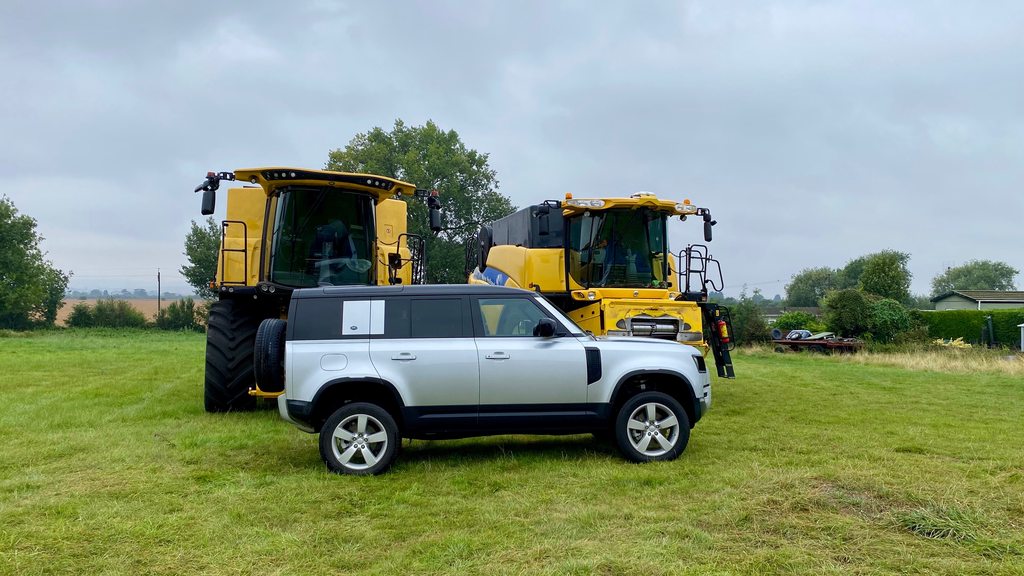
Where should someone start when reviewing the new Land Rover Defender? It seems to be such a contentious subject. And no matter what your views are, you will likely end up truly upsetting one camp or another.
Well, let us start with something descriptive. The model under review is a ‘First Edition’ 110. Being as this is the UK it comes fairly loaded with kit and only one engine option, being the 2.0 D240 turbo diesel, along with the only gearbox choice offered on the new Defender. The 8-speed ZF unit that adorns so many modern vehicles. With a retail price of approx £60,000 it is certainly not aimed at being a budget 4x4.
On face value the Defender 110 seems very similar to the Discovery 5, which is also offered for similar money with this same engine and gearbox combo. And is built on a similar variation of the D7 platform. The Discovery 5 has a marginally shorter wheelbase, but quite similar in most dimensions. The skeptic in me, would ask. Is the Defender little more than a mild styling change from the D5, just offered in two alternative wheelbases? Or are there more fundamental engineering differences between them?
While on the subject of value, looking back at some old figures and inflation rates. I believe the new Defender is pitched at about the same price and market point or slightly higher, than a 1999 Range Rover p38 was. Which at the time was the most luxurious and top of the range model offered by Land Rover. How things have changed.
As the ‘old’ Defender has been cited as a great British icon many times over the years. I think reviewing the new models styling is of paramount importance before we jump into any kind of road test.
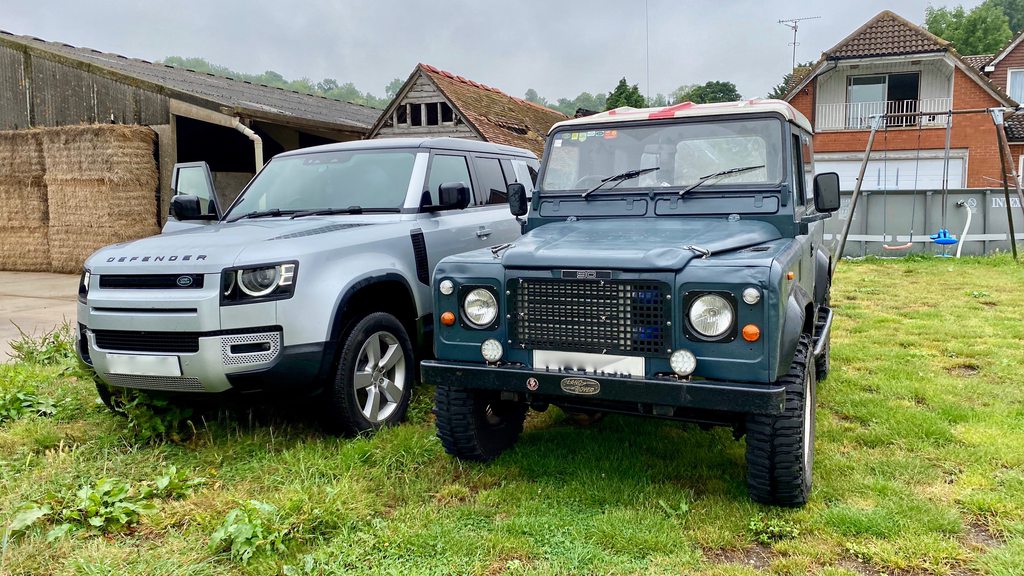
Personally I’m still a little undecided about the looks. From some angles it looks rather frumpy, even awkward. Yet from other angles it looks quite good. I do think the design is rather colour sensitive, which also includes the colour of the roof. And it does have some nice styling touches to it here and there. But here is the biggy, it just doesn’t look very “Land Rover Defender” at all. I can see no real trace of the 70 years of heritage that I would be expecting a vehicle such as this to be portraying. It is most odd. I can see rather a lot of “Discovery” in the design. From the rear tailgate to the alpine lights, stables of the Discovery 1 and 2 era. And in general shape, profile and silhouette it seems to have a strong family tie with the Discovery 3 and 4 models.
Ultimately it is completely lacking the classic lines that have made the Series and Defender models so iconic over the years. For me, as a green blooded lifelong Land Rover fanatic. I find this somewhat disappointing.
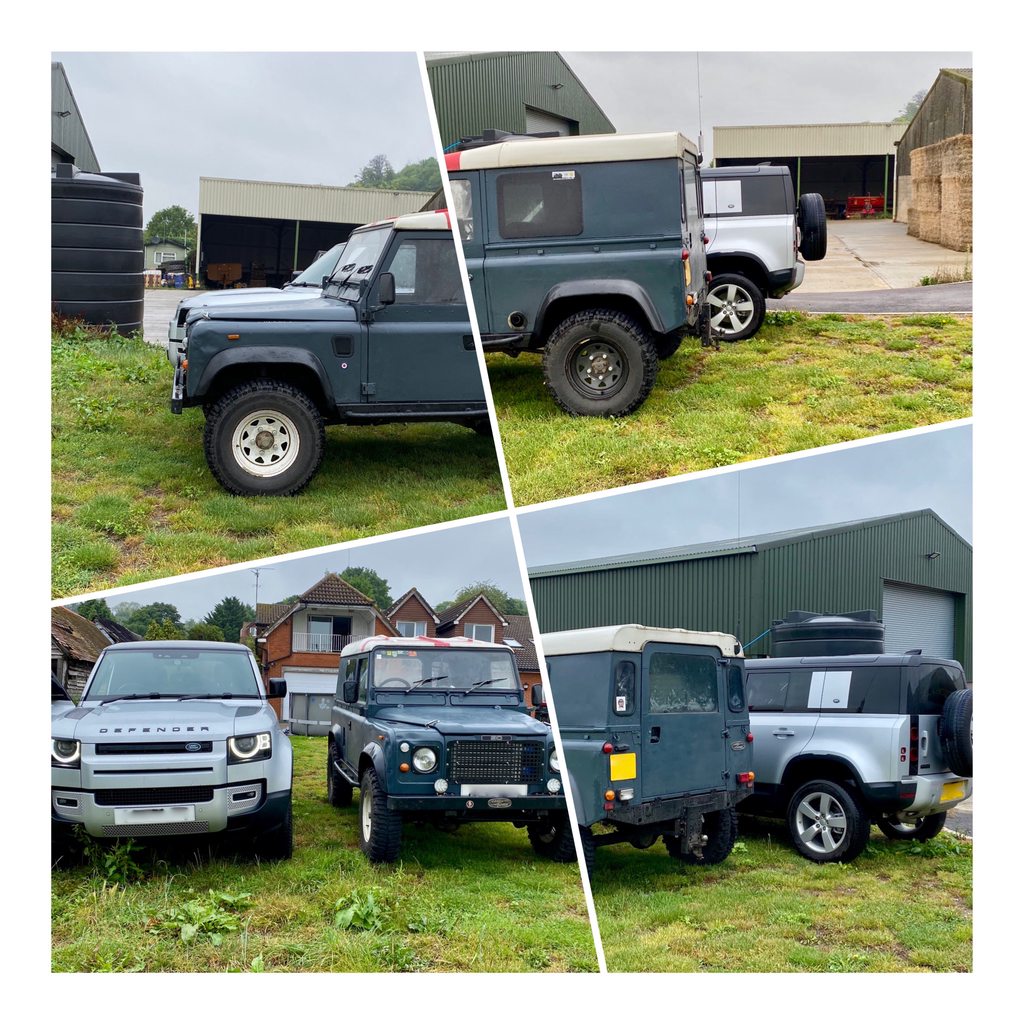
Inside is much the same. I actually like the interior a lot, it has some very nice design touches. Such as the grab handles for the rear passengers, to make getting in and out easier.
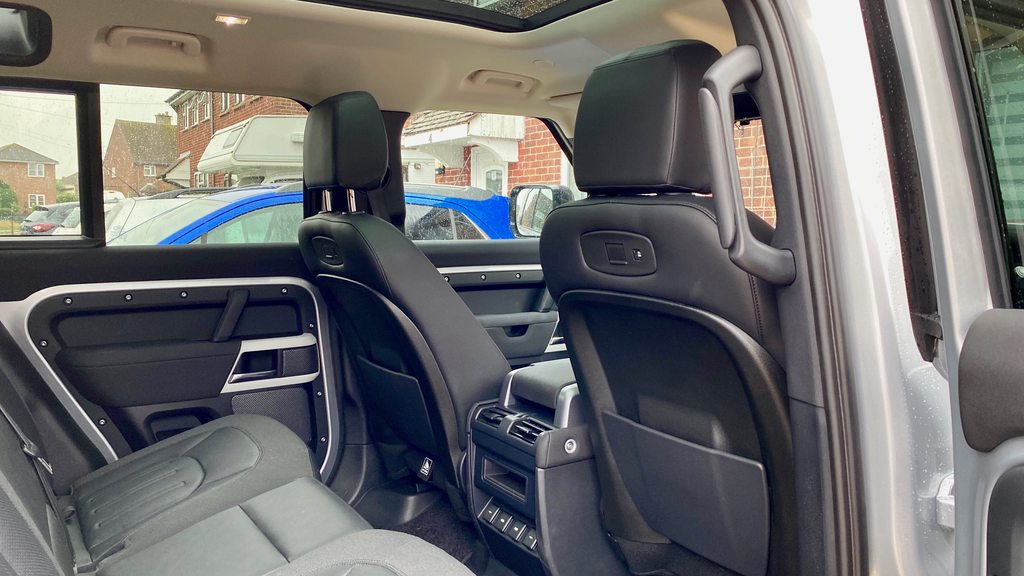
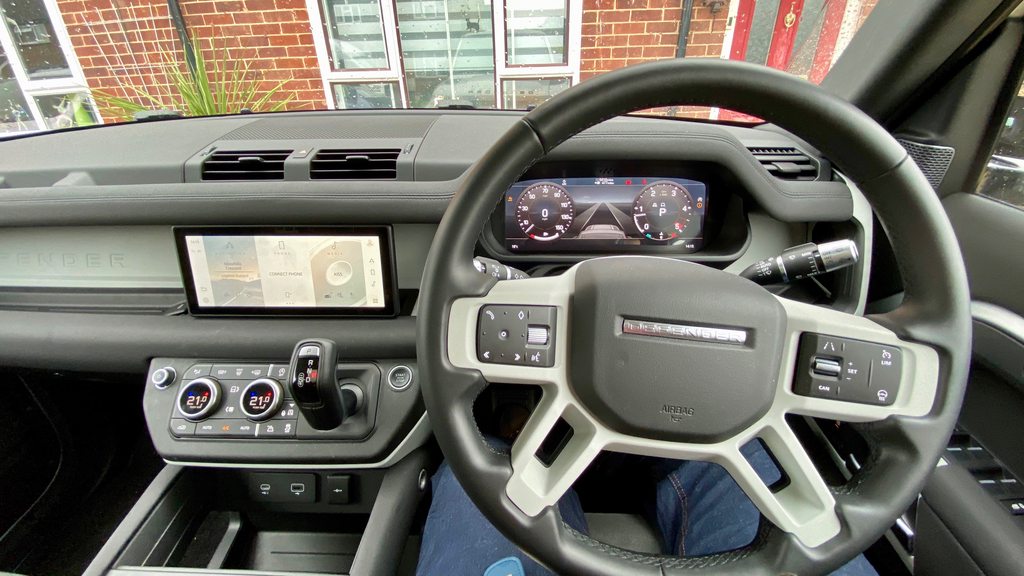
There is also a good amount of storage cubbies and some well placed USB ports. But again oddly, there seems to be nothing very “Defender” about the interior. I know there is a big stamped DEFENDER in the dash, but the old ones never had this. Nor did they have stylised door cards with purposeful exposed allen head bolts.
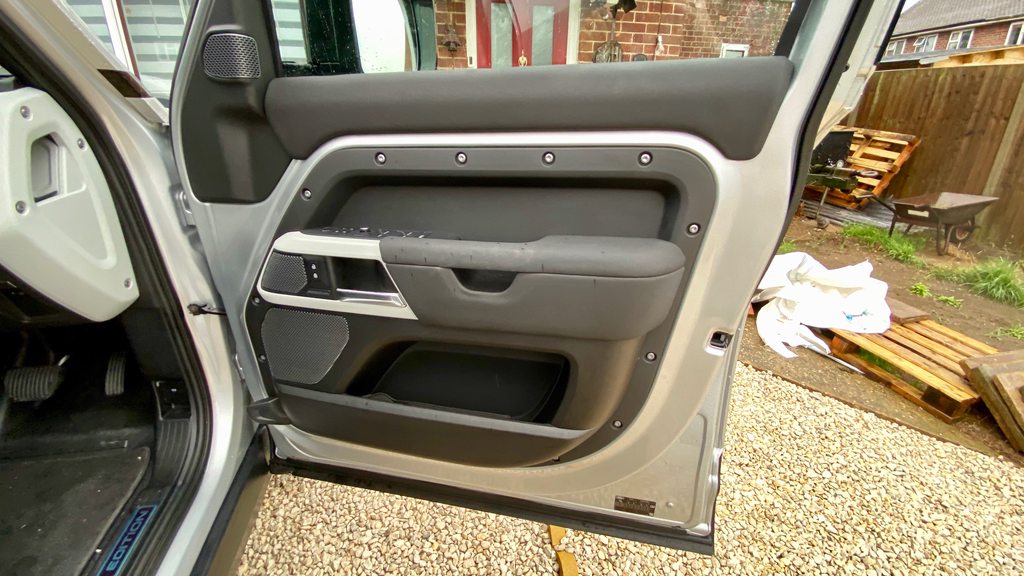
The tray in the dash is a nice touch, but the dash in general just seems as though it has been designed by someone who once heard Land Rover made a vehicle called a Defender. But had never actually bothered to sit in one.
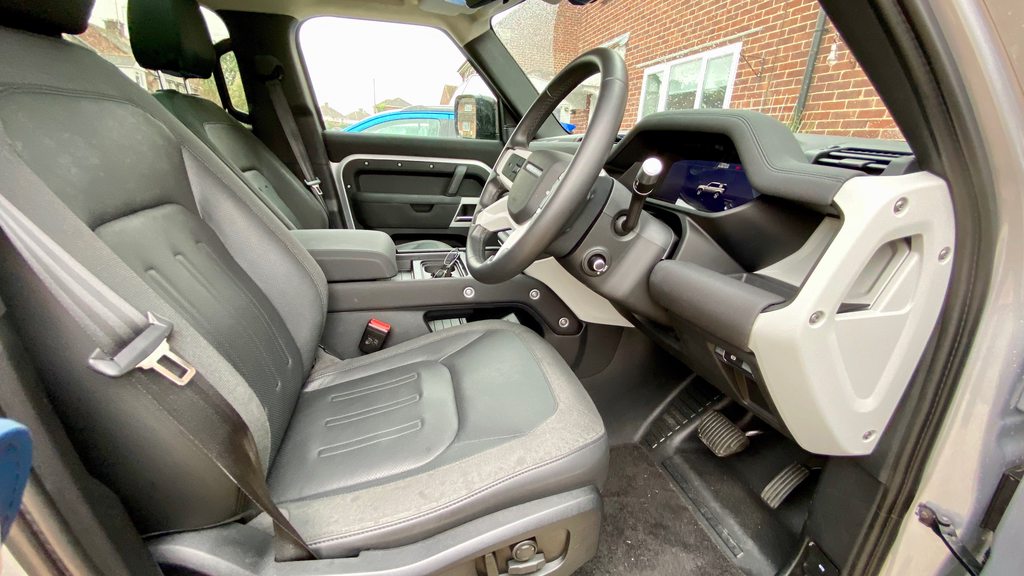
Also, from where you sit, to where the front of the vehicle ends. You’d kind of expect there to be a V12 under the bonnet. You really are a long long way back. With a windscreen rake that shares nothing with any past Series or Defender models.
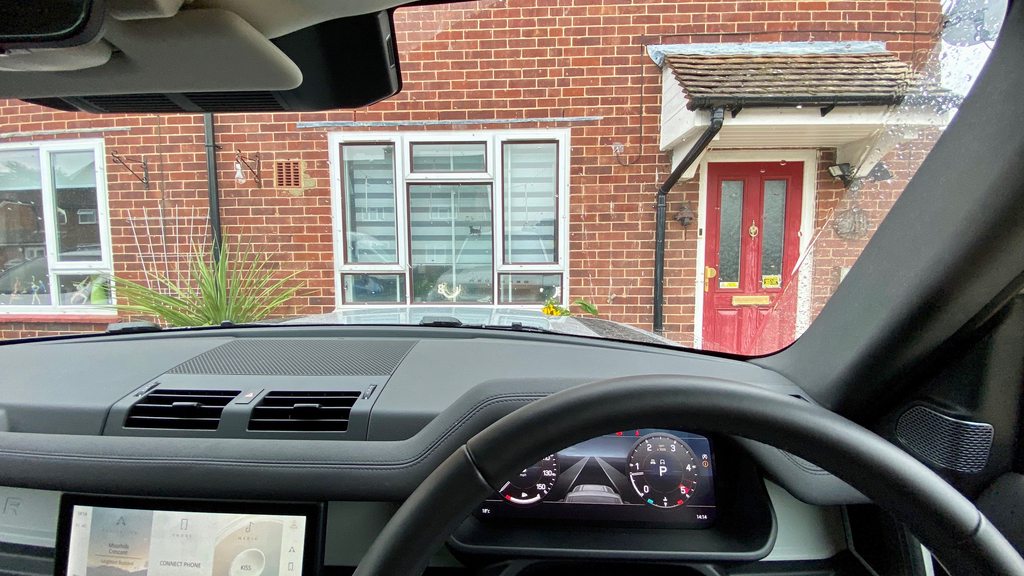
That said, if I have complaints with the interior, it is not this. The cabin is a nice place to be, it is light and airy, the large glass roof is very pleasant. And the surfaces feel good to the touch. The door top and dash appear to have a nice soft touch feel which I really liked. Although as I found out later on, this material did not take kindly to mud at all. In general the interior is a triumph to behold. Even with the cloth seats, although the drivers one did look a little stained and had some early signs of wear.
There is however a vastly bigger problem with the interior. Or more specifically, looking out from the interior. The new Defender is blessed with the worst blind spots I have yet come across in any vehicle. And since passing my test in 1997, I have driven a great many. There are several major concerns here. Firstly, the mirrors are pretty hopeless. Something that any past Defender owners will likely be shocked to hear, as the mirrors on the old models are brilliant. These new ones are not a patch on the old ones. For me, I also found that to adjust the mirrors correctly, quite a bit of glass became completely hidden by the mirror cowling, thus making the poor mirrors even worse. And as for the blind spot, when you include the large A-pillar and mirror locations, they become quite a burden. Never have I been unable to see down the road when turning left out of a T-junction. But this is a party trick the new Defender seemed far too well versed in!
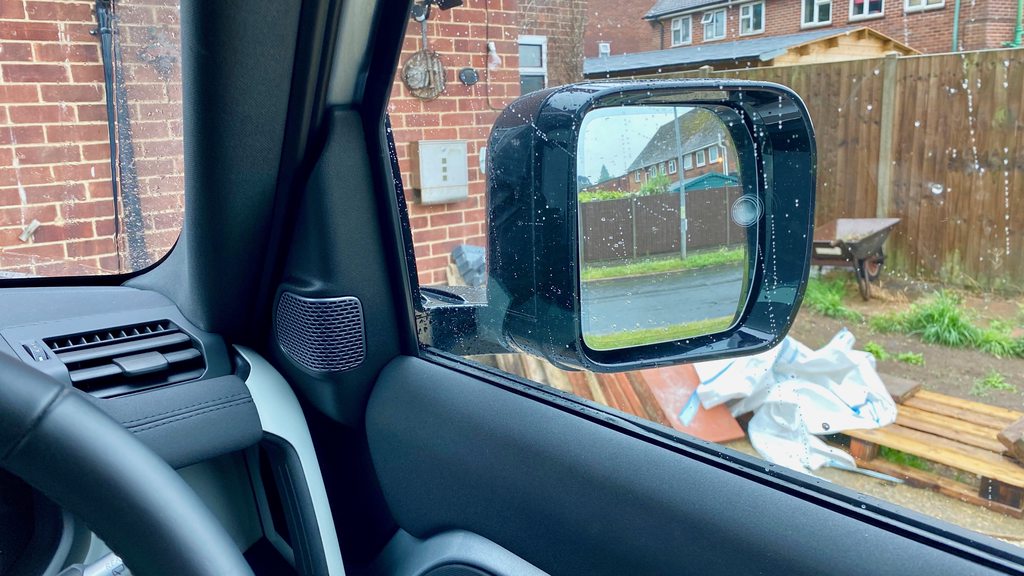
In fairness, I am not the tallest person in the world. So I did have the seat quite far forward. Well, we can’t all be strapping 6 footers can we. However, even moving the seat back a small amount for a more average sized person, I do not see how such a major issue would be easily overcome.
While there is more that could be said about the interior, I think this is plenty for now. So let us head out on to the road and see what it goes like.
As mentioned, this is the 240bhp version, which from a 2.0 litre diesel engine is quite impressive. And I’ll be honest, I thought the engine was a complete gem. It sounded pretty good, revved and went very very well. The Defender will even pick its skirt up and move at a fairly rapid rate if so desired. I’m not for a moment suggesting it was setting the world on fire performance wise and I’m sure if you were used to the grunt of a TDV8 found in past Land Rover products, you’d probably find the D240 somewhat underwhelming. But for what it is, I was impressed. That said, I do suspect that the base model 200hp D200 variant may feel a little underpowered in such a big heavy heavy vehicle. My test mpg was approx 24mpg (Imperial).
Sadly though, there is some bad news. Well not bad, more catastrophic. Under some conditions the gearbox is the most dreadful, awful gearbox I’ve ever driven. Once rolling it went well enough and complimented the engine. The gear shifts were also smooth. The problem is twofold. It seems to be completely dimwitted at times and leaves you quite literally sitting in the road not moving.
There are two flavours of this. The first is from standstill, if you pull away normally, sometimes it would do nothing, I’m not entirely sure if this was the gearbox or the throttle. But the engine doesn’t rev and you don’t really move. Then it will suddenly lurch forward with little to no warning. This makes some kinds of normal road use quite horrid. Also despite being an automatic, it seemed to have an unwillingness to want to crawl when you lift off the brake pedal. The same being true for reverse. I suspect you could get used to it with enough seat time. But it would always be horrid. I found the only way to pull out from a T-junction was to prod the throttle quite hard, then as soon as the vehicle started to move, lift right off, then reapply some throttle. I can only presume, gone are the days of smooth driving?
Despite this horrible oddity, it gets worse. At other times you also get what appears to be a completely dead throttle pedal or lack of response from the gearbox. Usually on 90 degree turns, such as turning into a side road, or pulling out from a Give Way where you could keep rolling at 10-20mph. You go to accelerate in a normal fashion and you get nothing in return. Should you have been foolish enough to pull out in front of something, it will give you quite the puckering I can tell you. This problem is compounded by not being consistent either, because at other times under very similar circumstances, there is no delay at all and it’ll shoot off like a scalded cat!
I decided to experiment a bit with the gearbox and found that normal D or Sport mode made no real difference to this behaviour. And yet there was still one more party trick in store. If you come to a complete standstill, such as being at a roundabout or a junction, don’t hold it on the brake and don’t build any revs. Just stamp on the throttle pedal. My normal expectation would be for the vehicle to move away briskly and swiftly. In the Defender it does not move at all, it waits, then waits a bit longer. Then it eventually decides that it will move. The delay is simply enormous! To the point that it is comically concerning. Never have I driven anything like this.
If you were to give yourself a one, two, three countdown. And went to wide open throttle on three. You’d get to the count of five before you had any form of meaningful forward progression.
I do not know if this problem extends to other vehicles with this powertrain or if the petrol Defender would exhibit the same. But this singular major issue would be enough to turn me away from wanting to buy and own one of these. Hopefully it is just something software related and can be reprogrammed, but it would appear to be a deliberate design choice in how the Defender is intended to drive on the road. Put frankly, I know the ‘Defender’ is being brought into the so-called “Digital age”. However, I still prefer certain controls to have a degree analog feel to them.
On road ride and handling are very good. There is no denying, the all independent suspension setup does iron the bumps out very well. I wouldn’t say it is night and day difference from a good live axle vehicle. But it is certainly better. Handling too, it is level, grippy and direct with good steering. And will allow you to hustle the large vehicle along small lanes at quite a rate of Knots and with relative ease.
For me however, I think this is one of the biggest issues with a vehicle wearing the Defender nameplate. It just doesn’t feel like a 4x4 to drive. And that is a real shame. In fact, it feels like a large estate car. That just happens to be a bit taller. It therefore feels somewhat more boaty than a well sorted car. But completely lacks the sense of occasion that you would expect from something calling itself a Defender.
Anyone who has spent a lot of wheel time in a traditional Defender, Range Rover Classic or even an XJ Jeep Cherokee. Will be able to tell you, they all feel “special” to drive. There is just something about them. Something that makes you smile, something that is incredibly satisfying. And something that is very enjoyable. They are an event to pilot. And therefore an event to own and a pleasure to go out for a drive in, every single time you get in them.
The Defender by comparison feels supremely capable, but somewhat sterile. To the point that once the novelty of the interior styling has worn away. You could almost be driving any other generic SUV. It really is lacking a personality, which is odd. As its forebear had such a strong one.
This isn’t to say it is a bad car, it is not. It is a very good car, but that is perhaps the crux of the problem. It just feels like a car.
Let us talk about suspension for a bit. A topic that many may find uninteresting, but one that I personally find quite fascinating. And with any off road vehicle, should be a point of major discussion.
The Defender uses Land Rover’s trailed, tested and proven cross linked air suspension. Which hails from the introduction of the Discovery 3 model, way back in 2004. The current system is an evolution of that setup and is found on multiple current Land Rover products. It is a very good system, although one could argue it is an expensive and complex way of achieving similar off road performance to that of a live axle. With the aim being of the more car like on-road experience. A trade-off that is very good for some classes and types of vehicles I’m sure. But one I’m not yet fully convinced of for a Defender model.
To give the suspension a little test, I put a ramp in front of the drivers side front wheel and the passenger side rear wheel. A competent 4wd vehicle should have no problem driving in a controlled manner to the top of the ramps and back down. And it will enable us to see how the suspension reacts.
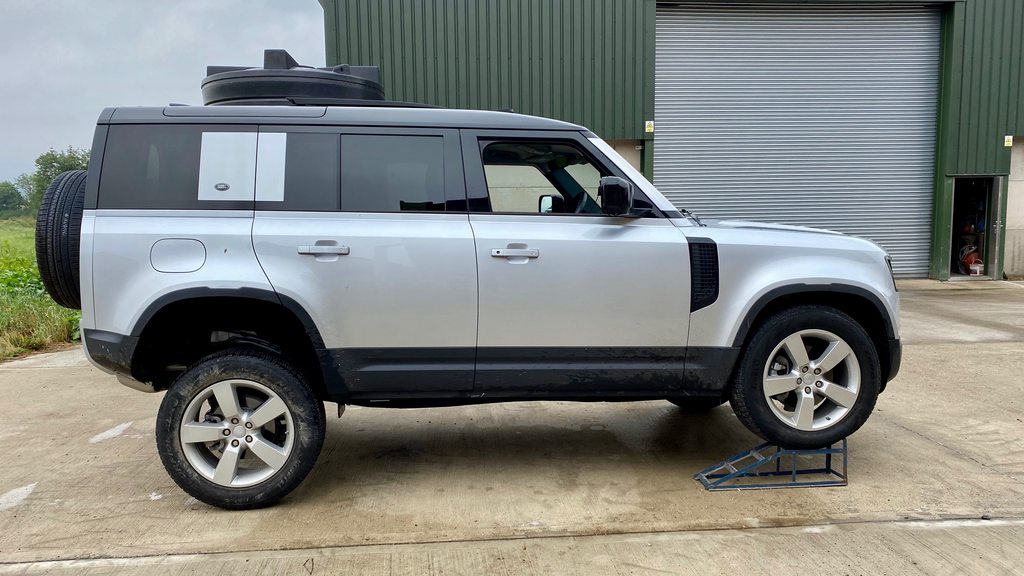
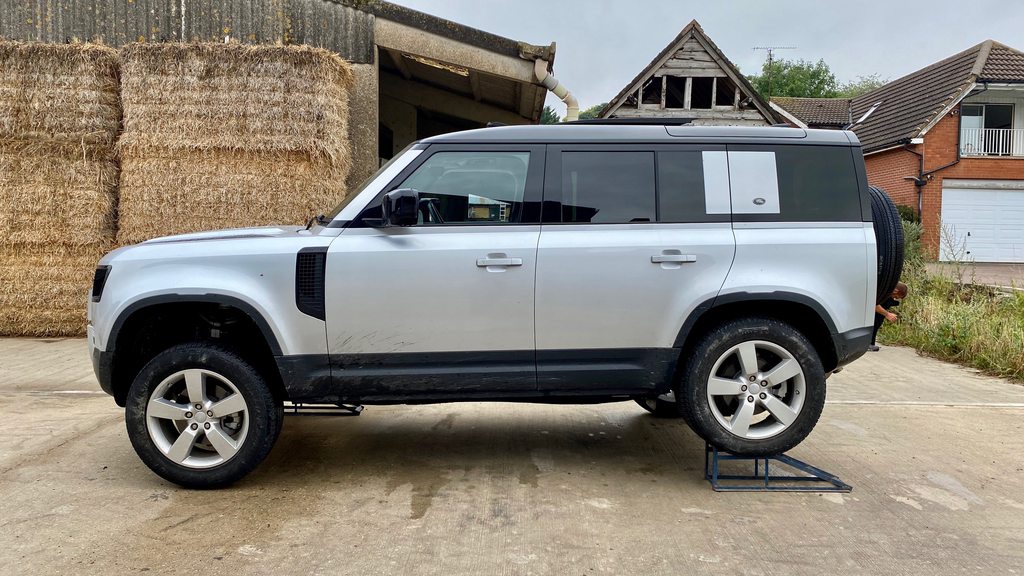
As this was done on a grippy surface I decided to use low range and the ‘Rock Crawl’ Terrain Response mode, which not only locks the centre differential. But also raises the ride height of the vehicle. Sadly, this vehicle wasn’t equipped with the optional rear Diff Locker.
The Rock Crawl mode should ensure a minimal amount of wheelslip and good throttle control.
The Defender drove up on the ramps no bother at all. Some very minor scrabbling of the left front wheel on the concrete, but nothing to be concerned with. Thankfully the vehicle also seemed to be very controlled on the throttle and smooth to drive.
The results speak for themselves really. Very impressive for an all independent setup. However it comes as no surprise, as we know a 16 year old Discovery 3 would do equally well at such a test. Still, it is nice to see how much “flex” there is and how much clearance.
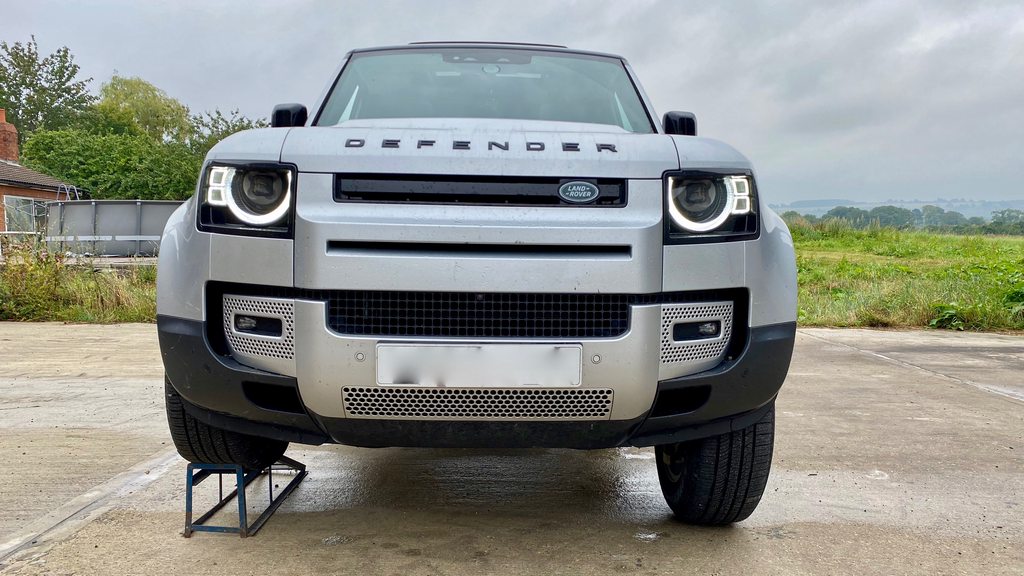
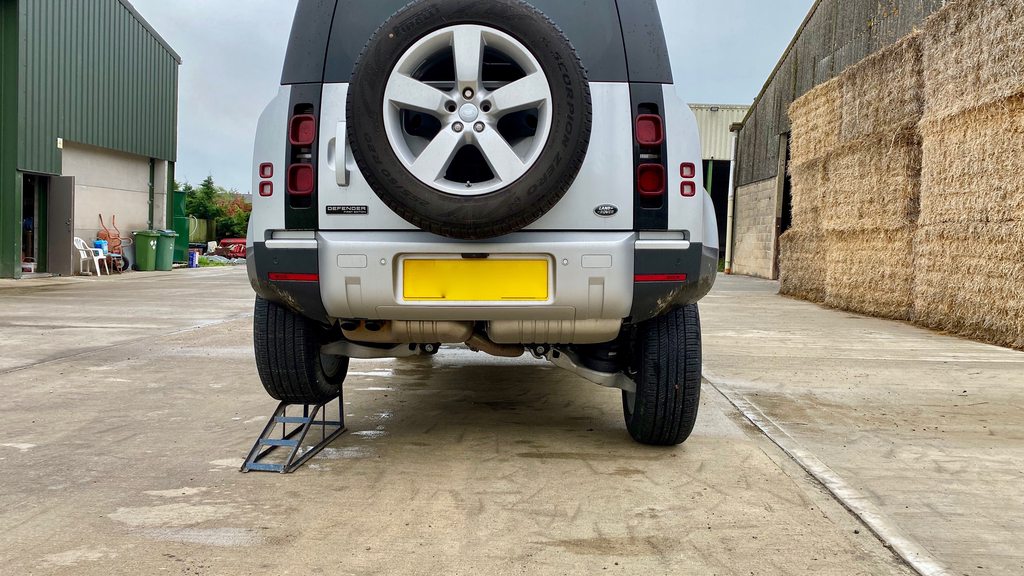
Of note however there are three things I’d like to mention here. Firstly, note the ride height gap (from the top of the tyre, to the bottom of the wheel arch), on the drivers front and passengers rear tyres. While the gap has reduced from sitting level, neither tyre is “stuffed” up into the arch as you would get on a live axle vehicle. The independent suspension just doesn’t compress in the same way as a live axle can.
The drivers rear and passenger front wheels are firmly on the ground. Which really demonstrates just how good the cross linked suspension setup is. And it is clear that there is plenty of droop in the suspension. However, my hunch is that despite this super performance on the ramps, the lack of compression will result in the all independent Defender, lifting its wheels off the ground more so than a live axle vehicle would do.
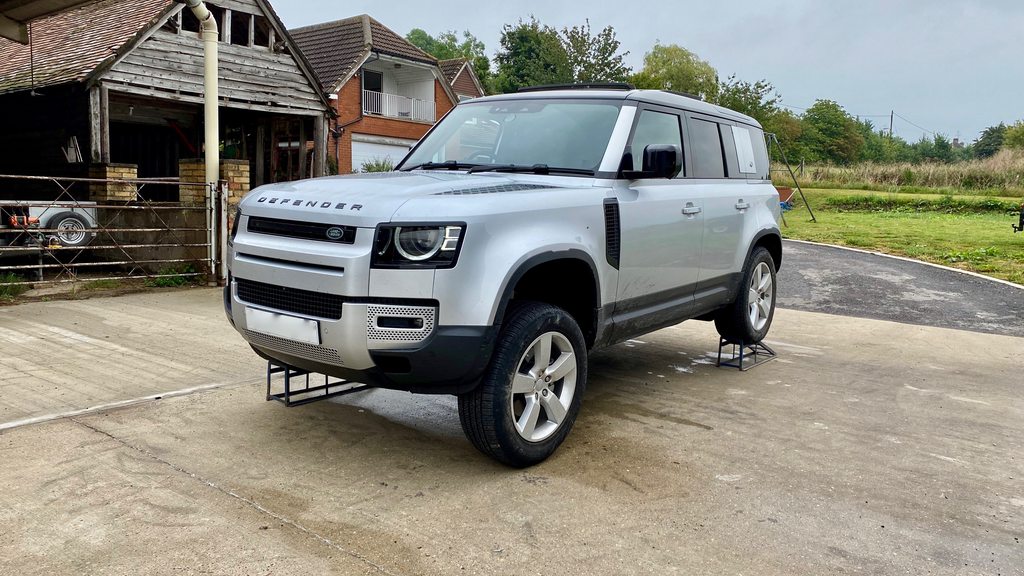
Secondly, and maybe of more importance. There is no driver feedback at all when driving onto the ramps and more surprisingly, also when reversing off of them. Because independent suspension only moves one wheel not the entire axle and is intended to isolate the rest of the car from the movement. You simply cannot easily feel the vehicle climbing the ramps and even less so when descending them. If I did not have someone spotting for me. I would have had no idea when I had reached the top of the ramps. Off road I suspect such isolation from what the vehicle is doing and the terrain is unlikely to be as good as it may sound and may make you work a lot harder to get over some obstacles, for the simple fact you can’t really tell what is going on when you are sitting in the driver's seat.
Lastly, is one of visibility. I know the new Defender has an array of very clever cameras. But sometimes you don’t want to be looking down at the screen in the middle of the dash. You want the window open and to be able to lean out. And due to the design of the new Defender, it is almost impossible to do this. I found I could not even see the front wheel from the driver's seat. And even sticking my camera out at arms length from the window, I could not see that there was a ramp sitting right in front of the driver's front tyre. A trait that further removes the driver from the environment and isolates them even more so. A trait that I feel may be fitting for some vehicles, but is completely at odds on a vehicle bearing the name of Defender.
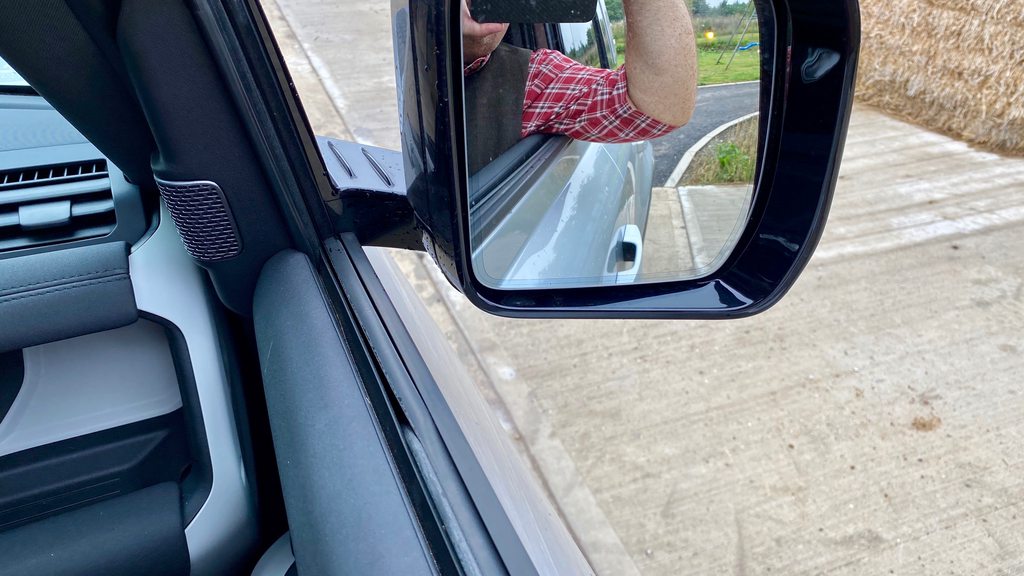
Now to the off road test section. It is such a shame about the weather, it is really wet and muddy out. Two days back it was dry, sunny and over 30 degrees. The new Defender is only equipped with road biased tyres. Therefore limiting traction on the slippery wet mud and grass. Had it been dry, I would have been able to test it in more severe cross axle situations and had another location I would have used as well.
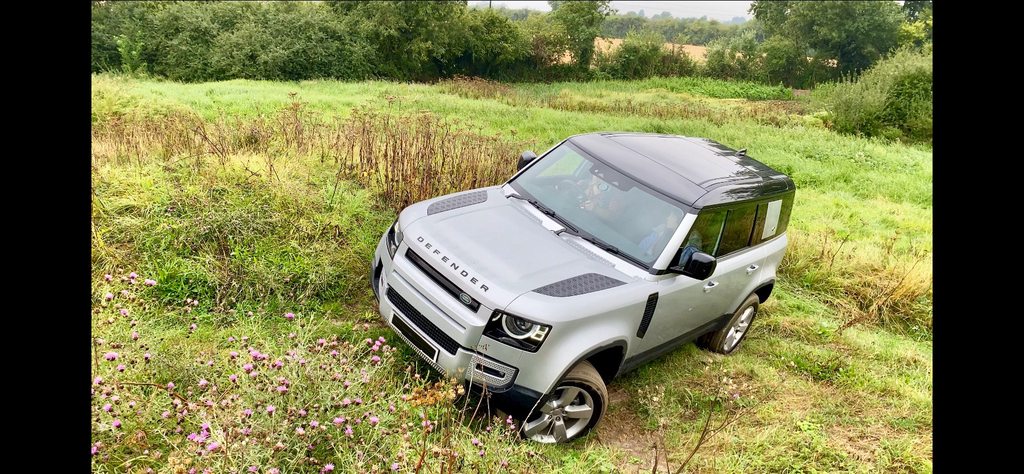
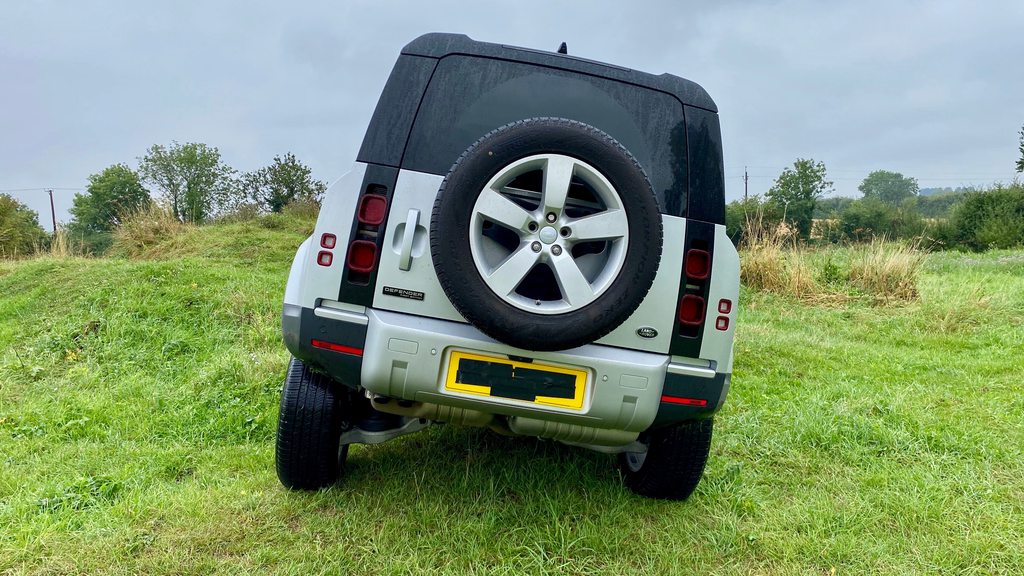
As this isn’t a tyre test, the off road test is a little limited to where the tyres could get us. That said, it was a worthy experiment. The test course is by no means extreme, but it is more severe than your average green lane. And therefore will give the suspension and traction systems a work out.
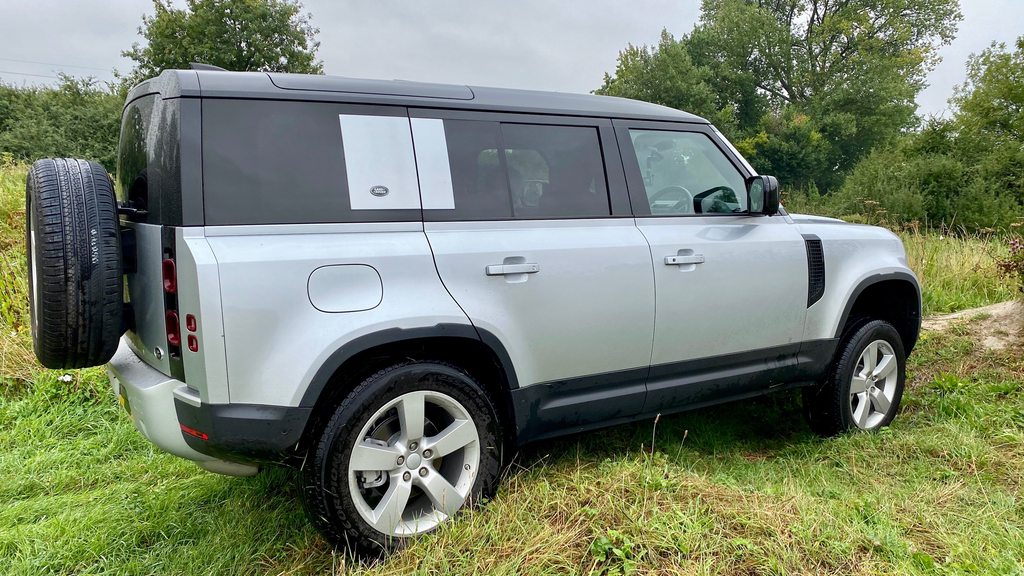
From the Terrain Response I selected ‘Mud & Ruts’ as that would seem to fit the description of the terrain.
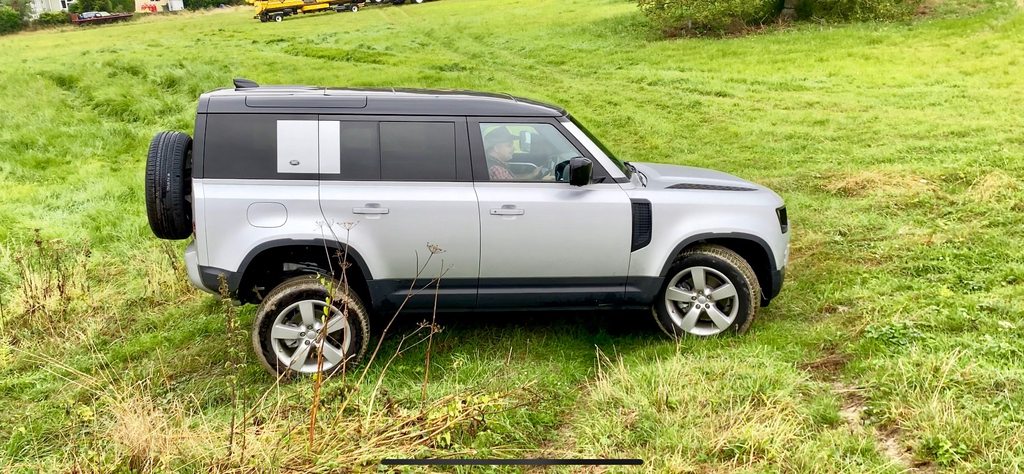
For a vehicle with a 119” wheelbase, I thought it did very well. With such a long wheelbase I would expect it to belly out due to the relatively poor breakover angle a long wheelbase usually gives you. And sure enough it did indeed beached itself and hit the underside a bit. But despite this, I am still impressed.
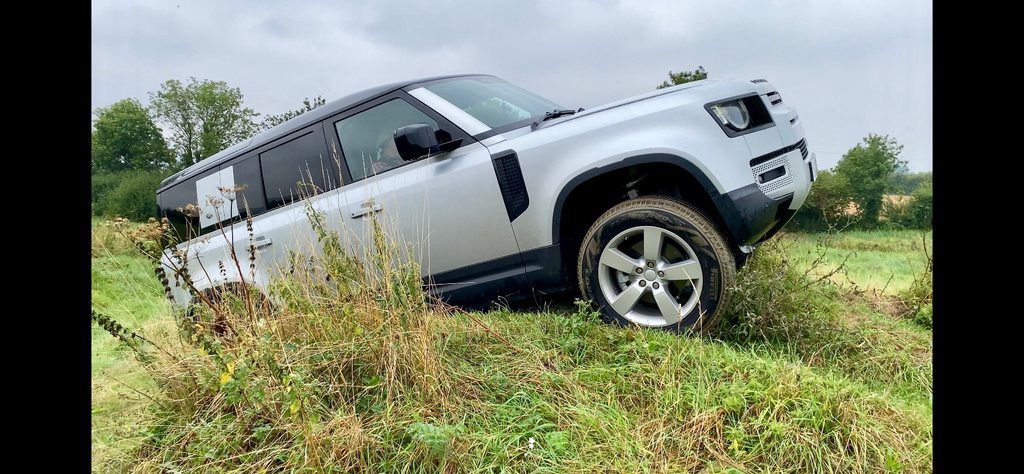
And for such a road biased vehicle, the Defender is certainly capable on such terrain. But given how well we know a Discovery 3 can drive off road, this is of no real surprise really.
As expected however, it did end up with wheels in the air quite a lot, which just goes to show, despite how well it appeared to ‘flex’ on the test ramps. The independent setup still struggles to keep the tyres in contact with the ground the same way a live axle 4x4 can.
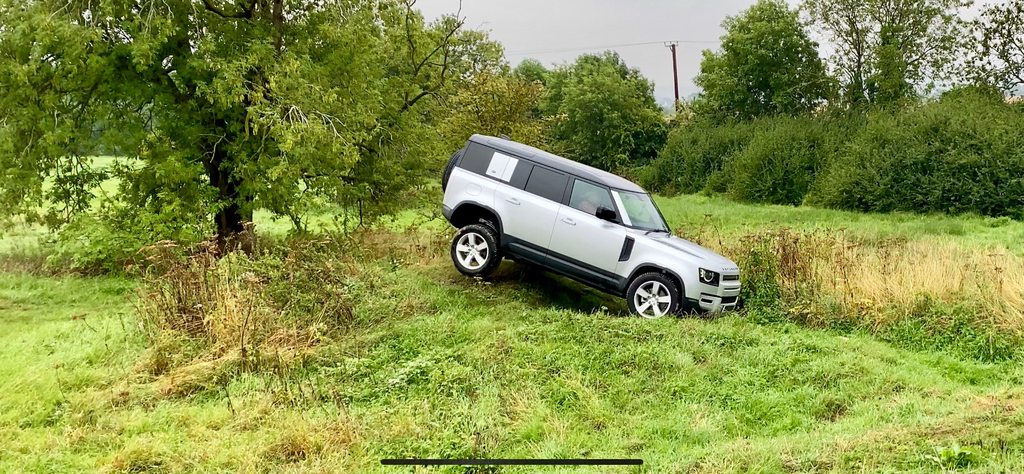
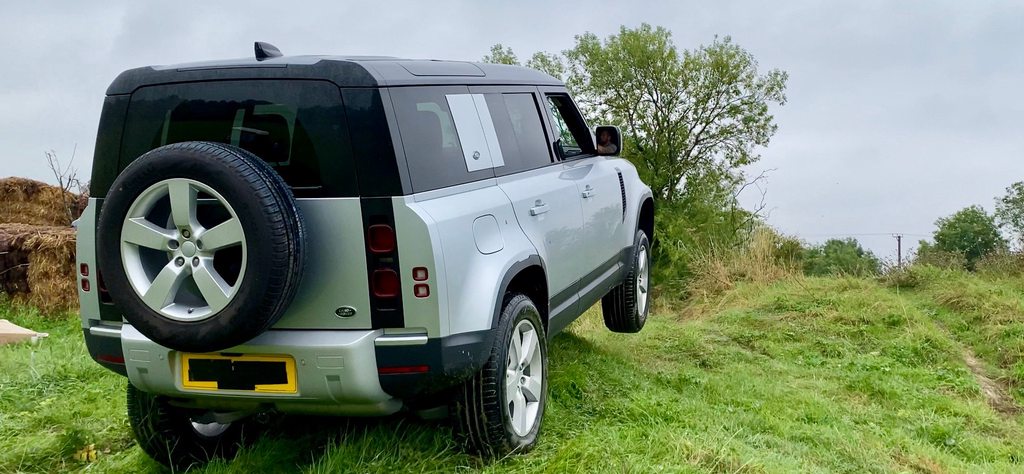
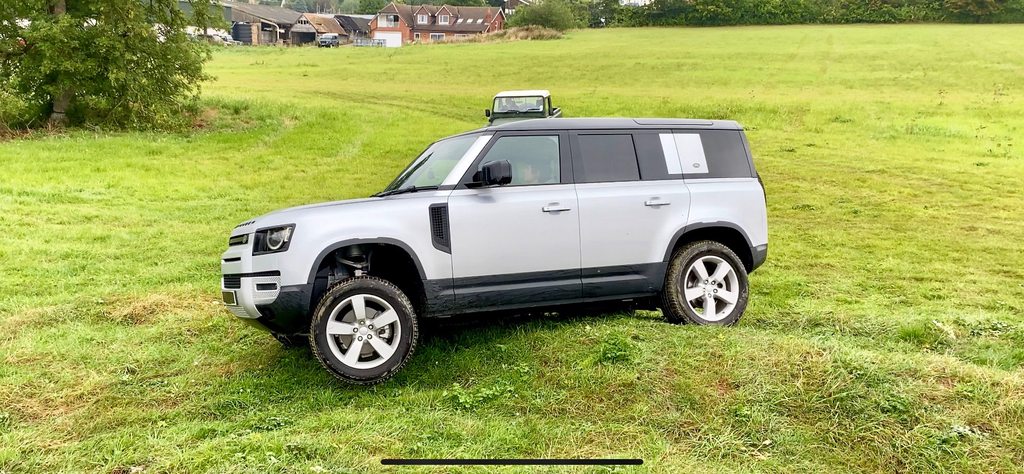
And I think this contributes to one of my biggest observations off road. That while the independent suspension rides better on the road and on rough farm tracks. Once the going gets a bit tougher and it starts lifting wheels off the ground and working the traction control systems, it actually is less comfortable off road than a live axle vehicle.
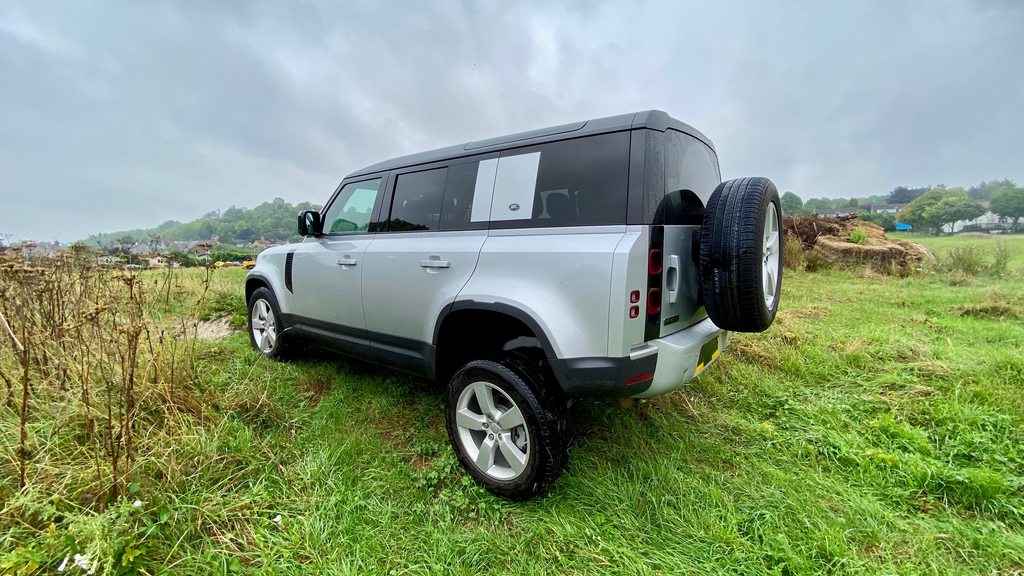
As luck would have it, we were able to directly compare to a 1999 Range Rover Vogue SE. The old Range Rover is the last of the live axle Range Rover’s and uses a setup unique to the p38a model. It is also equipped with 4 wheel traction control, a 4 speed automatic gearbox, with a manual override button to keep it in gear and lock the torque converter up.
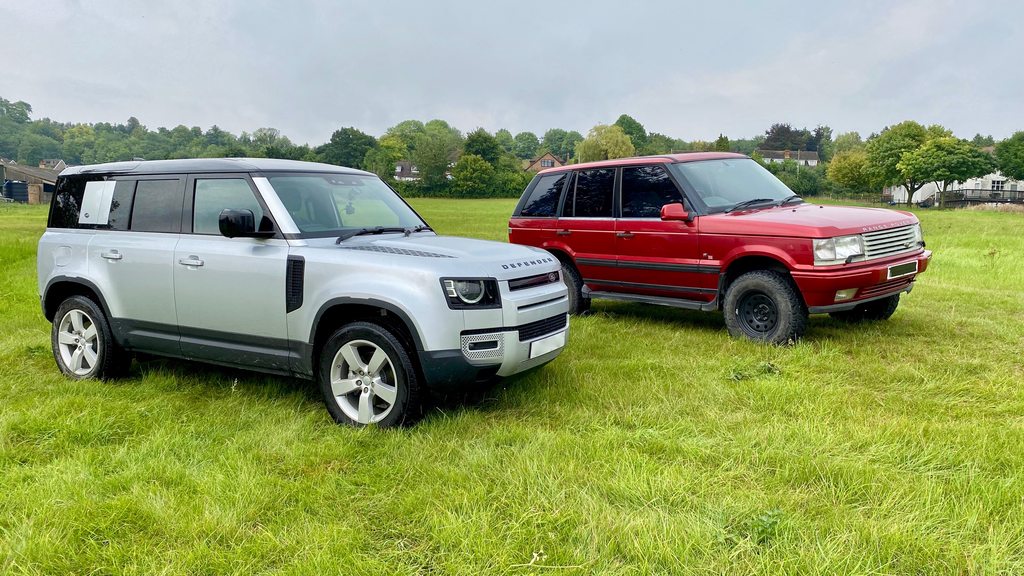
Back to back, the Range Rover just felt more sure footed, more comfortable with more control. It didn’t want to run away from you, it would hold it speeds on the uneven ground better. And managed to keep all its wheels on the ground. It gave you a more secure feeling overall.
The old Range Rover really did give you the sense that you could ‘ford every river and climb every mountain’. The new Defender always had you a little more on edge and required more concentration and more effort.
Don’t let this seem as a disjustice for the new Defender. It is still incredibly capable and likely would vastly exceed the off road requirements of many owners.
But I’m not convinced that what it has gained (or lost) on road with such a suspension setup is really worth the compromises off road compared to a more traditional 4x4 setup. Which takes me back to my earlier point. If you want a large estate car that has the potential to go up the field. The new Defender is ideal. If however you are wanting an off road 4x4 that feels special to drive. This new model seems to be very wide of the mark.
Underneath the new Defender seemed to cope quite well, it is well tucked up. With some strategically placed bash plates. Although the rest of the underside is covered in some kind of fibreboard.
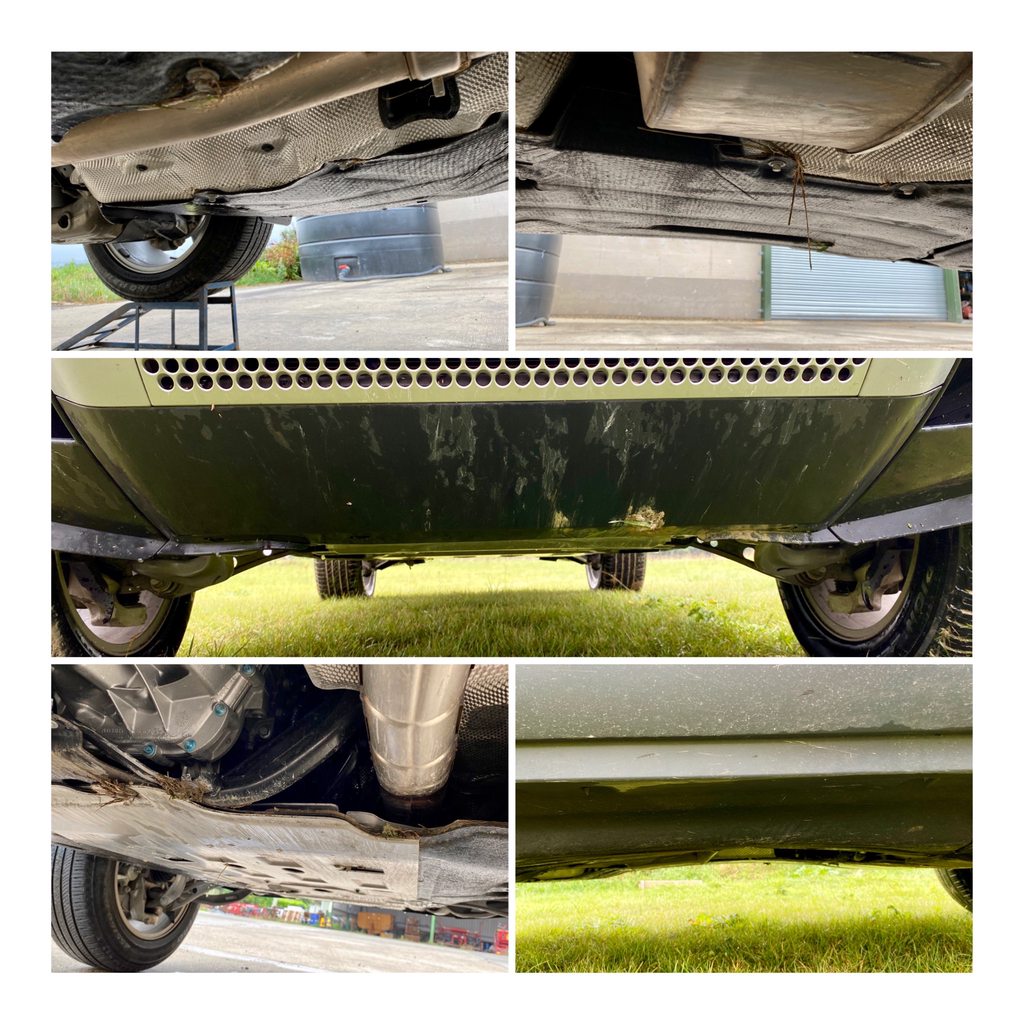
My last biggest issue with the new Defender is the Terrain Response system. I know it was revolutionary when introduced. And many a manufacturer has copied the basic idea. However, it is a hugely complex and fiddly system. You really do need to be an expert on the vehicle to have any clue what each mode does. And then you really need to be an expert off road to know which mode to use for which situation. As it isn’t always as obvious as it may seem.
For instance, the Mud & Ruts setting seemed to kill the throttle with too much wheelspin, something that was unhelpful in such slippery conditions. To which I’m sure the average punter wouldn’t know what they should do in order to overcome this deficit, such as use a different mode that allows more wheelslip.
But this is only part of the problem in the new Defender. In the past Terrain Response and the suspension controls had easy to reach and identify dedicated controls. In the new Defender the controls are somewhat unobvious, semi-hidden behind the gearstick and not very intuitive to use. For example, there is a button for Low Range, but no obvious way to return to High Range. And when selecting different Terrain Settings you sometimes get additional pop up messages or messages being split between the central screen and the dash pod screen.
To even activate Terrain Response you have to firstly find a discreetly placed button to turn one of the temperature dials into a control for the Terrain Response. It is almost as if Land Rover don’t really want you using these controls regularly and have made them difficult to get too and use.
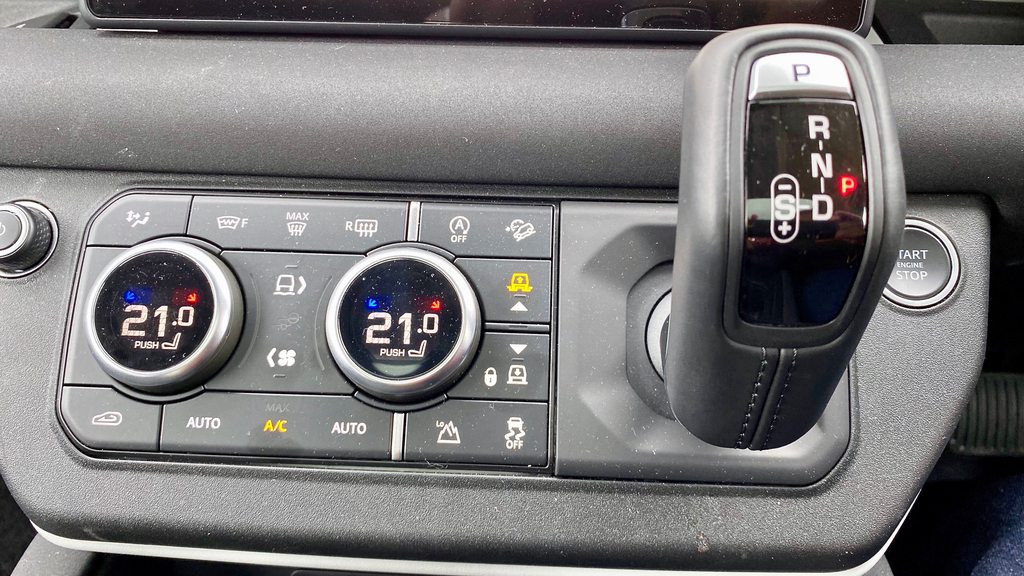
Some other points of note during the review process. There was a rattle from the rear of the Defender. I think I eventually traced this to some loose trim on the rear tailgate. There was also a vibration rattle in the dash under hard acceleration at around 4000rpm. And sadly during the test it developed a new rattle from the drivers door. All on a vehicle that had only covered 5000 miles.
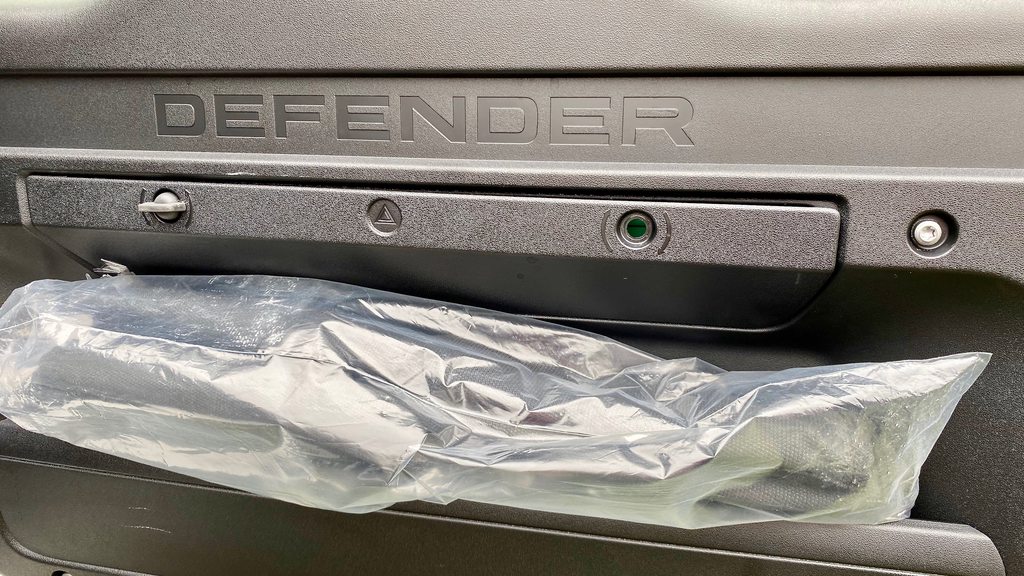
In summary, as impressive and as capable as the new Defender is. It is a complete miss for me. It just seems to have no real Defender qualities about it on pretty much any level. I do wonder if the Defender Sport name should have been used on this model. It would certainly be more fitting with the design, capabilities and styling.
If I was to Pretend that this was badged as a Defender SPORT, I would give it 7.5 / 10. The poor blind spots and horrid delay on the gearbox dock major points off.
If I was to rate it based on being a Defender, then my score would be 2.5 / 10. It is just too far removed from what one would expect a Defender to be.
Video Review:

Where should someone start when reviewing the new Land Rover Defender? It seems to be such a contentious subject. And no matter what your views are, you will likely end up truly upsetting one camp or another.
Well, let us start with something descriptive. The model under review is a ‘First Edition’ 110. Being as this is the UK it comes fairly loaded with kit and only one engine option, being the 2.0 D240 turbo diesel, along with the only gearbox choice offered on the new Defender. The 8-speed ZF unit that adorns so many modern vehicles. With a retail price of approx £60,000 it is certainly not aimed at being a budget 4x4.
On face value the Defender 110 seems very similar to the Discovery 5, which is also offered for similar money with this same engine and gearbox combo. And is built on a similar variation of the D7 platform. The Discovery 5 has a marginally shorter wheelbase, but quite similar in most dimensions. The skeptic in me, would ask. Is the Defender little more than a mild styling change from the D5, just offered in two alternative wheelbases? Or are there more fundamental engineering differences between them?
While on the subject of value, looking back at some old figures and inflation rates. I believe the new Defender is pitched at about the same price and market point or slightly higher, than a 1999 Range Rover p38 was. Which at the time was the most luxurious and top of the range model offered by Land Rover. How things have changed.
As the ‘old’ Defender has been cited as a great British icon many times over the years. I think reviewing the new models styling is of paramount importance before we jump into any kind of road test.

Personally I’m still a little undecided about the looks. From some angles it looks rather frumpy, even awkward. Yet from other angles it looks quite good. I do think the design is rather colour sensitive, which also includes the colour of the roof. And it does have some nice styling touches to it here and there. But here is the biggy, it just doesn’t look very “Land Rover Defender” at all. I can see no real trace of the 70 years of heritage that I would be expecting a vehicle such as this to be portraying. It is most odd. I can see rather a lot of “Discovery” in the design. From the rear tailgate to the alpine lights, stables of the Discovery 1 and 2 era. And in general shape, profile and silhouette it seems to have a strong family tie with the Discovery 3 and 4 models.
Ultimately it is completely lacking the classic lines that have made the Series and Defender models so iconic over the years. For me, as a green blooded lifelong Land Rover fanatic. I find this somewhat disappointing.

Inside is much the same. I actually like the interior a lot, it has some very nice design touches. Such as the grab handles for the rear passengers, to make getting in and out easier.


There is also a good amount of storage cubbies and some well placed USB ports. But again oddly, there seems to be nothing very “Defender” about the interior. I know there is a big stamped DEFENDER in the dash, but the old ones never had this. Nor did they have stylised door cards with purposeful exposed allen head bolts.

The tray in the dash is a nice touch, but the dash in general just seems as though it has been designed by someone who once heard Land Rover made a vehicle called a Defender. But had never actually bothered to sit in one.

Also, from where you sit, to where the front of the vehicle ends. You’d kind of expect there to be a V12 under the bonnet. You really are a long long way back. With a windscreen rake that shares nothing with any past Series or Defender models.

That said, if I have complaints with the interior, it is not this. The cabin is a nice place to be, it is light and airy, the large glass roof is very pleasant. And the surfaces feel good to the touch. The door top and dash appear to have a nice soft touch feel which I really liked. Although as I found out later on, this material did not take kindly to mud at all. In general the interior is a triumph to behold. Even with the cloth seats, although the drivers one did look a little stained and had some early signs of wear.
There is however a vastly bigger problem with the interior. Or more specifically, looking out from the interior. The new Defender is blessed with the worst blind spots I have yet come across in any vehicle. And since passing my test in 1997, I have driven a great many. There are several major concerns here. Firstly, the mirrors are pretty hopeless. Something that any past Defender owners will likely be shocked to hear, as the mirrors on the old models are brilliant. These new ones are not a patch on the old ones. For me, I also found that to adjust the mirrors correctly, quite a bit of glass became completely hidden by the mirror cowling, thus making the poor mirrors even worse. And as for the blind spot, when you include the large A-pillar and mirror locations, they become quite a burden. Never have I been unable to see down the road when turning left out of a T-junction. But this is a party trick the new Defender seemed far too well versed in!

In fairness, I am not the tallest person in the world. So I did have the seat quite far forward. Well, we can’t all be strapping 6 footers can we. However, even moving the seat back a small amount for a more average sized person, I do not see how such a major issue would be easily overcome.
While there is more that could be said about the interior, I think this is plenty for now. So let us head out on to the road and see what it goes like.
As mentioned, this is the 240bhp version, which from a 2.0 litre diesel engine is quite impressive. And I’ll be honest, I thought the engine was a complete gem. It sounded pretty good, revved and went very very well. The Defender will even pick its skirt up and move at a fairly rapid rate if so desired. I’m not for a moment suggesting it was setting the world on fire performance wise and I’m sure if you were used to the grunt of a TDV8 found in past Land Rover products, you’d probably find the D240 somewhat underwhelming. But for what it is, I was impressed. That said, I do suspect that the base model 200hp D200 variant may feel a little underpowered in such a big heavy heavy vehicle. My test mpg was approx 24mpg (Imperial).
Sadly though, there is some bad news. Well not bad, more catastrophic. Under some conditions the gearbox is the most dreadful, awful gearbox I’ve ever driven. Once rolling it went well enough and complimented the engine. The gear shifts were also smooth. The problem is twofold. It seems to be completely dimwitted at times and leaves you quite literally sitting in the road not moving.
There are two flavours of this. The first is from standstill, if you pull away normally, sometimes it would do nothing, I’m not entirely sure if this was the gearbox or the throttle. But the engine doesn’t rev and you don’t really move. Then it will suddenly lurch forward with little to no warning. This makes some kinds of normal road use quite horrid. Also despite being an automatic, it seemed to have an unwillingness to want to crawl when you lift off the brake pedal. The same being true for reverse. I suspect you could get used to it with enough seat time. But it would always be horrid. I found the only way to pull out from a T-junction was to prod the throttle quite hard, then as soon as the vehicle started to move, lift right off, then reapply some throttle. I can only presume, gone are the days of smooth driving?
Despite this horrible oddity, it gets worse. At other times you also get what appears to be a completely dead throttle pedal or lack of response from the gearbox. Usually on 90 degree turns, such as turning into a side road, or pulling out from a Give Way where you could keep rolling at 10-20mph. You go to accelerate in a normal fashion and you get nothing in return. Should you have been foolish enough to pull out in front of something, it will give you quite the puckering I can tell you. This problem is compounded by not being consistent either, because at other times under very similar circumstances, there is no delay at all and it’ll shoot off like a scalded cat!
I decided to experiment a bit with the gearbox and found that normal D or Sport mode made no real difference to this behaviour. And yet there was still one more party trick in store. If you come to a complete standstill, such as being at a roundabout or a junction, don’t hold it on the brake and don’t build any revs. Just stamp on the throttle pedal. My normal expectation would be for the vehicle to move away briskly and swiftly. In the Defender it does not move at all, it waits, then waits a bit longer. Then it eventually decides that it will move. The delay is simply enormous! To the point that it is comically concerning. Never have I driven anything like this.
If you were to give yourself a one, two, three countdown. And went to wide open throttle on three. You’d get to the count of five before you had any form of meaningful forward progression.
I do not know if this problem extends to other vehicles with this powertrain or if the petrol Defender would exhibit the same. But this singular major issue would be enough to turn me away from wanting to buy and own one of these. Hopefully it is just something software related and can be reprogrammed, but it would appear to be a deliberate design choice in how the Defender is intended to drive on the road. Put frankly, I know the ‘Defender’ is being brought into the so-called “Digital age”. However, I still prefer certain controls to have a degree analog feel to them.
On road ride and handling are very good. There is no denying, the all independent suspension setup does iron the bumps out very well. I wouldn’t say it is night and day difference from a good live axle vehicle. But it is certainly better. Handling too, it is level, grippy and direct with good steering. And will allow you to hustle the large vehicle along small lanes at quite a rate of Knots and with relative ease.
For me however, I think this is one of the biggest issues with a vehicle wearing the Defender nameplate. It just doesn’t feel like a 4x4 to drive. And that is a real shame. In fact, it feels like a large estate car. That just happens to be a bit taller. It therefore feels somewhat more boaty than a well sorted car. But completely lacks the sense of occasion that you would expect from something calling itself a Defender.
Anyone who has spent a lot of wheel time in a traditional Defender, Range Rover Classic or even an XJ Jeep Cherokee. Will be able to tell you, they all feel “special” to drive. There is just something about them. Something that makes you smile, something that is incredibly satisfying. And something that is very enjoyable. They are an event to pilot. And therefore an event to own and a pleasure to go out for a drive in, every single time you get in them.
The Defender by comparison feels supremely capable, but somewhat sterile. To the point that once the novelty of the interior styling has worn away. You could almost be driving any other generic SUV. It really is lacking a personality, which is odd. As its forebear had such a strong one.
This isn’t to say it is a bad car, it is not. It is a very good car, but that is perhaps the crux of the problem. It just feels like a car.
Let us talk about suspension for a bit. A topic that many may find uninteresting, but one that I personally find quite fascinating. And with any off road vehicle, should be a point of major discussion.
The Defender uses Land Rover’s trailed, tested and proven cross linked air suspension. Which hails from the introduction of the Discovery 3 model, way back in 2004. The current system is an evolution of that setup and is found on multiple current Land Rover products. It is a very good system, although one could argue it is an expensive and complex way of achieving similar off road performance to that of a live axle. With the aim being of the more car like on-road experience. A trade-off that is very good for some classes and types of vehicles I’m sure. But one I’m not yet fully convinced of for a Defender model.
To give the suspension a little test, I put a ramp in front of the drivers side front wheel and the passenger side rear wheel. A competent 4wd vehicle should have no problem driving in a controlled manner to the top of the ramps and back down. And it will enable us to see how the suspension reacts.


As this was done on a grippy surface I decided to use low range and the ‘Rock Crawl’ Terrain Response mode, which not only locks the centre differential. But also raises the ride height of the vehicle. Sadly, this vehicle wasn’t equipped with the optional rear Diff Locker.
The Rock Crawl mode should ensure a minimal amount of wheelslip and good throttle control.
The Defender drove up on the ramps no bother at all. Some very minor scrabbling of the left front wheel on the concrete, but nothing to be concerned with. Thankfully the vehicle also seemed to be very controlled on the throttle and smooth to drive.
The results speak for themselves really. Very impressive for an all independent setup. However it comes as no surprise, as we know a 16 year old Discovery 3 would do equally well at such a test. Still, it is nice to see how much “flex” there is and how much clearance.


Of note however there are three things I’d like to mention here. Firstly, note the ride height gap (from the top of the tyre, to the bottom of the wheel arch), on the drivers front and passengers rear tyres. While the gap has reduced from sitting level, neither tyre is “stuffed” up into the arch as you would get on a live axle vehicle. The independent suspension just doesn’t compress in the same way as a live axle can.
The drivers rear and passenger front wheels are firmly on the ground. Which really demonstrates just how good the cross linked suspension setup is. And it is clear that there is plenty of droop in the suspension. However, my hunch is that despite this super performance on the ramps, the lack of compression will result in the all independent Defender, lifting its wheels off the ground more so than a live axle vehicle would do.

Secondly, and maybe of more importance. There is no driver feedback at all when driving onto the ramps and more surprisingly, also when reversing off of them. Because independent suspension only moves one wheel not the entire axle and is intended to isolate the rest of the car from the movement. You simply cannot easily feel the vehicle climbing the ramps and even less so when descending them. If I did not have someone spotting for me. I would have had no idea when I had reached the top of the ramps. Off road I suspect such isolation from what the vehicle is doing and the terrain is unlikely to be as good as it may sound and may make you work a lot harder to get over some obstacles, for the simple fact you can’t really tell what is going on when you are sitting in the driver's seat.
Lastly, is one of visibility. I know the new Defender has an array of very clever cameras. But sometimes you don’t want to be looking down at the screen in the middle of the dash. You want the window open and to be able to lean out. And due to the design of the new Defender, it is almost impossible to do this. I found I could not even see the front wheel from the driver's seat. And even sticking my camera out at arms length from the window, I could not see that there was a ramp sitting right in front of the driver's front tyre. A trait that further removes the driver from the environment and isolates them even more so. A trait that I feel may be fitting for some vehicles, but is completely at odds on a vehicle bearing the name of Defender.

Now to the off road test section. It is such a shame about the weather, it is really wet and muddy out. Two days back it was dry, sunny and over 30 degrees. The new Defender is only equipped with road biased tyres. Therefore limiting traction on the slippery wet mud and grass. Had it been dry, I would have been able to test it in more severe cross axle situations and had another location I would have used as well.


As this isn’t a tyre test, the off road test is a little limited to where the tyres could get us. That said, it was a worthy experiment. The test course is by no means extreme, but it is more severe than your average green lane. And therefore will give the suspension and traction systems a work out.

From the Terrain Response I selected ‘Mud & Ruts’ as that would seem to fit the description of the terrain.

For a vehicle with a 119” wheelbase, I thought it did very well. With such a long wheelbase I would expect it to belly out due to the relatively poor breakover angle a long wheelbase usually gives you. And sure enough it did indeed beached itself and hit the underside a bit. But despite this, I am still impressed.

And for such a road biased vehicle, the Defender is certainly capable on such terrain. But given how well we know a Discovery 3 can drive off road, this is of no real surprise really.
As expected however, it did end up with wheels in the air quite a lot, which just goes to show, despite how well it appeared to ‘flex’ on the test ramps. The independent setup still struggles to keep the tyres in contact with the ground the same way a live axle 4x4 can.



And I think this contributes to one of my biggest observations off road. That while the independent suspension rides better on the road and on rough farm tracks. Once the going gets a bit tougher and it starts lifting wheels off the ground and working the traction control systems, it actually is less comfortable off road than a live axle vehicle.

As luck would have it, we were able to directly compare to a 1999 Range Rover Vogue SE. The old Range Rover is the last of the live axle Range Rover’s and uses a setup unique to the p38a model. It is also equipped with 4 wheel traction control, a 4 speed automatic gearbox, with a manual override button to keep it in gear and lock the torque converter up.

Back to back, the Range Rover just felt more sure footed, more comfortable with more control. It didn’t want to run away from you, it would hold it speeds on the uneven ground better. And managed to keep all its wheels on the ground. It gave you a more secure feeling overall.
The old Range Rover really did give you the sense that you could ‘ford every river and climb every mountain’. The new Defender always had you a little more on edge and required more concentration and more effort.
Don’t let this seem as a disjustice for the new Defender. It is still incredibly capable and likely would vastly exceed the off road requirements of many owners.
But I’m not convinced that what it has gained (or lost) on road with such a suspension setup is really worth the compromises off road compared to a more traditional 4x4 setup. Which takes me back to my earlier point. If you want a large estate car that has the potential to go up the field. The new Defender is ideal. If however you are wanting an off road 4x4 that feels special to drive. This new model seems to be very wide of the mark.
Underneath the new Defender seemed to cope quite well, it is well tucked up. With some strategically placed bash plates. Although the rest of the underside is covered in some kind of fibreboard.

My last biggest issue with the new Defender is the Terrain Response system. I know it was revolutionary when introduced. And many a manufacturer has copied the basic idea. However, it is a hugely complex and fiddly system. You really do need to be an expert on the vehicle to have any clue what each mode does. And then you really need to be an expert off road to know which mode to use for which situation. As it isn’t always as obvious as it may seem.
For instance, the Mud & Ruts setting seemed to kill the throttle with too much wheelspin, something that was unhelpful in such slippery conditions. To which I’m sure the average punter wouldn’t know what they should do in order to overcome this deficit, such as use a different mode that allows more wheelslip.
But this is only part of the problem in the new Defender. In the past Terrain Response and the suspension controls had easy to reach and identify dedicated controls. In the new Defender the controls are somewhat unobvious, semi-hidden behind the gearstick and not very intuitive to use. For example, there is a button for Low Range, but no obvious way to return to High Range. And when selecting different Terrain Settings you sometimes get additional pop up messages or messages being split between the central screen and the dash pod screen.
To even activate Terrain Response you have to firstly find a discreetly placed button to turn one of the temperature dials into a control for the Terrain Response. It is almost as if Land Rover don’t really want you using these controls regularly and have made them difficult to get too and use.

Some other points of note during the review process. There was a rattle from the rear of the Defender. I think I eventually traced this to some loose trim on the rear tailgate. There was also a vibration rattle in the dash under hard acceleration at around 4000rpm. And sadly during the test it developed a new rattle from the drivers door. All on a vehicle that had only covered 5000 miles.

In summary, as impressive and as capable as the new Defender is. It is a complete miss for me. It just seems to have no real Defender qualities about it on pretty much any level. I do wonder if the Defender Sport name should have been used on this model. It would certainly be more fitting with the design, capabilities and styling.
If I was to Pretend that this was badged as a Defender SPORT, I would give it 7.5 / 10. The poor blind spots and horrid delay on the gearbox dock major points off.
If I was to rate it based on being a Defender, then my score would be 2.5 / 10. It is just too far removed from what one would expect a Defender to be.
Video Review:
Last edited:
